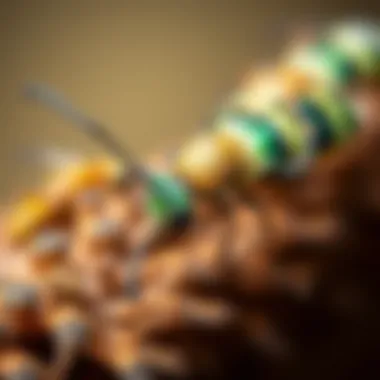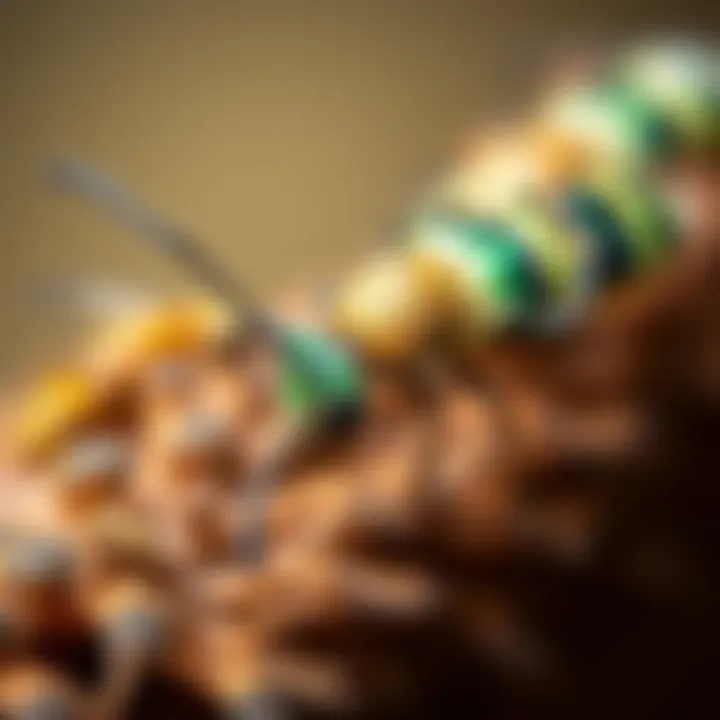Effective Chem-Free Pest Control Strategies in Austin


Intro
Pest management is a crucial concern for homeowners, particularly in a vibrant region like Austin, where the warmth invites a variety of pests. Many are starting to look beyond traditional chemical pesticides, recognizing the myriad benefits of chemical-free solutions. This guide gives an in-depth look into natural pest control methods, equipping you with the knowledge to address infestations while maintaining an environmentally-friendly mindset.
By understanding the importance of pest identification, prevention strategies, and treatment options, you can create a harmonious living space without resorting to harsh chemicals. Whether you are battling ants invading your pantry or mosquitoes buzzing around your backyard, this comprehensive guide will help you tackle pest issues head-on.
Preface to Chem-Free Pest Control
In an age where environmental consciousness and personal health take center stage, the relevance of chemical-free pest control can't be overstated. In Austin, with its unique climate and diverse ecosystem, homeowners are often faced with the challenge of keeping pests at bay while also protecting their families and the environment from harmful chemicals. The move towards chem-free pest management isn't just a trend; it's a shift towards greater sustainability and responsible living.
Adopting chemical-free methods often involves a holistic understanding of pest behaviors and ecosystem interactions. This guide sheds light on several vital aspects that housewives and homeowners should consider: the health implications of traditional pest control methods, the environmental footprint of chemical treatments, and the practicality of natural alternatives.
Understanding Pest Control
Pest control is a practice aimed at regulating or managing populations of unwanted organisms, typically insects or rodents. While the conventional approach has heavily relied on chemical pesticides, a growing body of research reveals that these solutions can lead to long-term damage. Here’s what you should know:
- Types of Pests: The term "pest" encapsulates a wide range of creatures, from ants and termites to fleas and roaches. Each type of pest requires a tailored approach to manage effectively.
- Impact of Chemicals: While chemicals can be effective in the short term, their lingering residues can contaminate the air and water. This can pose serious health risks, especially for young children and pets who are often more vulnerable.
- Natural Solutions: Understanding natural pest control methods is key. Techniques such as using essential oils, relying on beneficial insects like ladybugs, or implementing physical barriers can be effective in maintaining a pest-free home without the collateral damage associated with chemical pesticides.
- Education and Awareness: Knowledge is power. Becoming familiar with pest behaviors and habitats can empower homeowners to take proactive measures rather than just reactive ones.
"The best way to manage pests is to adopt an understanding of their nature and environment."
Understanding these elements is essential for anyone looking to explore a more resilient and sustainable approach to pest management. By choosing to go chem-free, residents can promote a healthier home and community, ensuring that both their families and the environment thrive.
The Importance of Going Chemical-Free
Choosing to go chemical-free in pest control is not just a trend; it's a significant shift towards a healthier lifestyle for both humans and the environment. In a city like Austin, where the sun shines bright and the land is rich, adopting a chemical-free approach can help maintain a balance—protecting our families and preserving the natural beauty around us. Let’s dive into why this decision matters so much today.
Health Concerns Related to Chemical Treatments
When it comes to chemical treatments, the potential health risks are something that homeowners should not overlook. The poisons and pesticides often used in these treatments can create an indoor environment that is far from safe. Reports have shown that exposure to harsh chemicals may lead to respiratory problems, skin irritations, or even more severe health issues over time.
Consider this: a family member with asthma may find their condition worsening after a pesticide application. That’s not just speculation; it’s a reality for many. These chemicals can linger in the air and on surfaces, becoming a health hazard long after their initial application. Protecting our loved ones means being aware of these dangers.
Moreover, children and pets are particularly vulnerable. Their developing bodies and smaller sizes make them more susceptible to harmful effects. A simple trip to the backyard can become a cause for concern if residues from chemical treatments are found on grass or play equipment. Therefore, opting for chemical-free methods translates into a significant reduction in health risks for everyone in the household.
Environmental Impact of Chemical Pesticides
The environmental footprint of chemical pesticides is another crucial aspect to consider. Many of these substances aren’t just harmful to pests; they can wreak havoc on entire ecosystems. When chemicals wash away into the soil or local waterways, they can harm beneficial organisms and contribute to broader issues like water pollution.
Here’s a thought: every time chemicals are poured onto a garden, they may end up affecting not just the targeted pests but also butterflies, bees, and other essential insects. The decline of pollinator populations due to pesticide usage is a pertinent concern. A reduction in these beneficial species can lead to a lack of biodiversity, which ultimately impacts food production and ecological balance.
One might ask, how can a household's choice of pest control reverberate beyond its walls? It's simple—what happens locally can affect the landscape regionally. For example, chemical runoff can pollute natural habitats for fish and wildlife. By choosing chemical-free alternatives, you’re not just safeguarding your home; you’re also playing a vital role in promoting a healthier ecosystem.
"Going chemical-free isn’t merely an individual choice—it’s a commitment to the well-being of our communities and our planet."
Common Pests in Austin
The unique environment of Austin makes it a hub for a variety of pests that can invade homes and gardens, causing not just nuisance but potential damage and health risks. Understanding which pests are prevalent in this region is crucial for homeowners seeking effective chemical-free pest control methods. Recognizing these pests enables one to take action early, often averting larger infestations that may require more intensive and costly measures.
Identifying Ants and Termites
Ants and termites can often be confused, but proper identification is essential to handle them effectively. Ants usually create visible trails and are often seen marching in lines, while termites typically operate silently, infesting wood unnoticed until serious damage is done. In Austin, the most common species include the fire ant, known for its painful sting, and the subterranean termite, which can severely compromise the integrity of wooden structures.
- Fire Ants: These pests are notorious for their aggressive behavior. If you come across a mound in your yard, it's wise to steer clear.
- Subterranean Termites: Beware of small mud tubes along your foundation, which signify their presence. Inspect any wooden areas regularly.
Utilizing traps baited with natural substances can help monitor and control these pests. For instance, a mixture of diatomaceous earth and sugar can lure ants while simultaneously deterring them due to its desiccating properties.


Common Rodents: Risks and Identification
Rodents can wreak havoc in households, particularly the house mouse and roof rat found in urban areas. These creatures not only nibble on food stocks but also carry diseases that pose health risks. Identifying signs of rodent activity involves looking for droppings and gnaw marks, as well as nests made from shredded materials.
Common signs include:
- Droppings: Small, dark pellets typically found in hidden corners or kitchen cabinets.
- Nests: Shredded paper or fabric often discovered in attics or crawl spaces.
To deter rodents, sealing entry points is crucial. Use steel wool or caulking to block holes where they might enter, or set traps with peanut butter to catch them without chemicals, ensuring a humane approach.
Fleas and Ticks: Understanding Risks
Fleas and ticks are not just annoying; they can also transmit serious diseases to both pets and humans. Fleas are notorious for their rapid reproduction and are often brought in by pets, while ticks are commonly found in grassy or wooded areas. Keeping an eye on your pet's health is paramount, as these pests can cause discomfort and severe conditions like Lyme disease.
Identification Tips:
- Fleas: Tiny and dark, often jumping quickly when disturbed.
- Ticks: Larger, flat, and oval-shaped; they attach firmly to the skin, making them harder to spot until they are engorged.
Control Measures:
- Regular vacuuming and washing pet bedding can help mitigate flea populations.
- For ticks, consider using essential oils like neem or cedarwood, which naturally repel these pests.
- Taking preventative measures, such as topicals or vet-recommended treatments, can greatly reduce the risk of infestation.
"Staying proactive is the key to keeping your home pest-free. Regular inspections can save you a lot of grief down the road."
By familiarizing oneself with these common pests and their indicators, homeowners can employ effective pest management strategies that align with a chemical-free approach. Understanding the specifics of pest behavior not only eases identification but also supports early intervention, thereby fostering a safer home environment.
Natural Pest Management Strategies
Natural pest management strategies focus on using environmentally friendly practices to control pests effectively. These methods are not just preferred for their eco-friendliness; they also address the long-term sustainability of our homes and health. In a place like Austin, where pests are a common nuisance, embracing these strategies can provide enduring solutions that enrich our living spaces.
Benefits of Natural Pest Management
Choosing chemical-free approaches means reducing the risk of harmful health effects for your family and pets. Chemical pesticides can linger in the air and embed themselves into surfaces, making them dangerous, especially for children. Furthermore, relying on natural methods can enhance plant health, preserve the ecosystem, and promote biodiversity. As you delve deeper into pest control, consider these elements:
- Healthier Living Environment: Natural methods foster a safer home atmosphere, minimizing exposure to toxic substances.
- Sustainable Practices: Ecosystem-friendly tactics can be part of everyday life, encouraging sustainable resources.
- Cost-effectiveness: While some natural methods may require initial investments, they often lead to lower costs over time, as fewer interventions are needed.
By integrating various natural pest management strategies, homeowners can make informed decisions that contribute to a healthier home and environment. The following sections detail three specific strategies that illustrate the practicality and effectiveness of this approach.
Using Essential Oils for Repelling Pests
Essential oils have gained traction in the realm of pest control due to their potent properties, acting as both repellents and deterrents. Oils such as peppermint, eucalyptus, and lavender are particularly effective at keeping common pests like ants and mosquitoes at bay. Their pleasant aroma is a bonus, masking the unpleasant odors that accompany chemical pesticides.
How to Use Essential Oils
- Diffusers: Adding a few drops of essential oil to a diffuser can purify the air while acting as a pest repellent.
- Spray Solutions: Mixing essential oils with water and a little soap can create an effective spray for repelling insects. The rosemary oil blend works wonders when combined with water in a spray bottle.
Biological Control: Beneficial Insects
Biological control refers to using natural predators to manage pest populations. In Austin, encouraging beneficial insects like ladybugs and lacewings can help control aphids and other garden pests. These natural defenders feed on unwanted pests, effectively reducing their numbers without external interventions.
Considerations for Biological Control
- Habitat Provision: Planting a diverse range of flowers can attract these beneficial insects. For instance, sunflowers and marigolds are known to invite ladybugs into the garden.
- Avoiding Chemicals: To maintain a balance, avoid using pesticides that could harm beneficial insects. Instead, focus on creating a hospitable environment for them.
Traps and Barriers: Mechanical Solutions
Mechanical solutions, including traps and barriers, present a straightforward way to manage pest issues without chemicals. These approaches can be applied both indoors and outdoors, depending on the level of infestation.
Types of Mechanical Solutions


- Traps: Sticky traps for insects and snap traps for rodents can quickly reduce populations without risk to humans and pets. These are especially useful in places like kitchens where food may attract pests.
- Barriers: Installing screens on windows and using caulk to seal cracks effectively prevent pests from entering your home. This simple step can save homeowners a multitude of headaches down the line.
Integrating these natural pest management strategies allows Austin residents to safeguard their homes while adopting sustainable practices that benefit both personal health and the environment. By choosing natural routes, you’re not just addressing a pest problem; you’re fostering a more responsible approach to living harmoniously within your surroundings.
Integrated Pest Management (IPM) Approach
The Integrated Pest Management (IPM) approach is a distinct corner stone of chem-free pest control. It's essential because it gathers a variety of natural and eco-friendly techniques, creating a rounded strategy that focuses on prevention, monitoring, and control. This not only keeps your home pest-free but also minimizes the negative impacts on the environment and human health. Homeowners in Austin can benefit significantly from this method, as it encourages a holistic view on pest management, leading to better long-term results.
The Principles of IPM
At its core, the IPM approach revolves around several guiding principles:
- Prevention: The first line of defense against pests is prevention. This involves identifying factors that attract pests to your location, such as food sources and breeding areas. Simple steps like sealing cracks and maintaining cleanliness can make a significant difference.
- Monitoring: Understanding pest populations is key. Regular inspections of your home and yard can help keep tabs on pest activity. Noticing a few ants outside doesn’t necessarily mean a full-blown infestation is on the way.
- Identification: Knowing what you’re dealing with is crucial for effective pest control. Accurate identification means not wasting time on unsuitable treatments for pests that are not an issue.
- Control Methods: Rather than relying on chemical applications, IPM focuses on low-impact control methods. This can involve using natural predators, mechanical traps, or even using organic pesticides as a last resort.
- Evaluation: Assessing the effectiveness of your pest control measures is necessary for future improvements. If a method isn’t working, revise your strategy.
By adhering to these principles, homeowners can develop a more balanced approach to pest management, ensuring that pest control is sustainable, effective, and aligned with a chemical-free philosophy.
Combining Strategies for Effective Control
The real magic happens when you start mixing and matching different strategies to build a pest control system that works nationally for your specific situation in Austin. Here are some effective combinations:
- Cultural Control with Biological Control: Changing the way you landscape or what you plant can minimize pest attraction. Incorporating flowers that attract beneficial insects can provide natural pest control solutions.
- Physical Barriers and Monitoring: Using physical barriers, such as mesh screens, along with regular checks for pests can create a powerful defense. It’s like having your cake and eating it too—keeping pests out while ensuring you’ve got an eye on any that dare to enter your home.
- Behavioral Control and Evaluation: Understanding the habits of common pests can inform how you set traps or use barriers effectively. For example, knowing when certain pests are most active can increase the likelihood of catching them in traps.
Implementing these combinations makes the IPM approach not just effective and sustainable, but also tailored exclusively to your environment.
"The cornerstone of pest management lies not in rigid strategies but evolving methods rooted in observation and adaptation to the environment at hand."
This adaptability not only leads to a pest-free home, but it also circumvents the issues posed by chemical treatments that often have long-lasting negative effects on surrounding ecosystems.
Local Resources for Pest Control in Austin
Navigating the world of pest control can be a daunting task, especially when trying to maintain a chemical-free home. In Austin, homeowners have access to various local resources to aid in pest management without the use of harmful chemicals. These resources not only provide expert guidance but also foster a supportive community for families seeking sustainable solutions. Utilizing local expertise creates a robust foundation for effective pest control strategies that align with environmentally-friendly practices.
Finding Local Pest Control Experts
When searching for pest control experts in Austin, it’s essential to identify professionals who are well-versed in chemical-free methods. Look for companies that emphasize natural treatments and have a proven track record in the field. Local resources such as the Austin Area Pest Control Association can be an excellent starting point. They maintain a directory of certified pest control experts who practice integrated pest management (IPM) techniques. Additionally, online platforms like Yelp or Google Reviews allow homeowners to read customer experiences and find reliable professionals.
Here are some tips for selecting the right pest control expert:
- Certifications: Verify certifications and licenses that ensure the company meets local regulations.
- Experience: Seek out experts who specifically focus on chemical-free solutions and have experience in addressing local pest issues.
- Consultations: Opt for professionals who offer free consultations. This ensures you get a feel for their expertise and approach before committing.
Remember: A knowledgeable expert can make all the difference, providing personalized strategies that align with the specific pest challenges in your area.
Community Programs and Support
Austin’s commitment to sustainability is reflected in various community programs focused on pest control and education. Programs through local environmental groups often offer workshops and informational sessions about natural pest control techniques. These initiatives not only educate homeowners but also foster a sense of community and shared responsibility toward the environment.
For instance, organizations like The Texas A&M AgriLife Extension provide resources about pest biology and sustainable practices. By participating in community events, homeowners can gain access to a wealth of knowledge while connecting with others who share similar concerns about pest management.
Here are some resources worth looking into:
- Local Extension Offices: They often host educational events on organic gardening and pest control methods.
- Community Gardens: These spaces may provide workshops focusing on organic pest management, allowing individuals to learn from one another.
- Social Media Groups: Platforms like Facebook, or Reddit have dedicated groups where residents share their experiences and advice on pest control solutions.
"Understanding your local resources can empower you and transform your approach to pest management. You’re not just protecting your home; you’re taking part in a larger effort towards sustainability."
By tapping into these local resources and community programs, homeowners in Austin can successfully address pest issues while adhering to eco-friendly practices. Whether it’s finding the right pest control expert or getting involved in community initiatives, these pathways will help create a pest-free environment that is also responsible and sustainable.
Debunking Myths about Pest Control


Understanding the realities surrounding pest control methods is crucial for homeowners considering chemical-free solutions. This section shines a light on common myths that often cloud judgment, affecting decisions regarding pest management. By debunking these misconceptions, readers can grasp the tangible benefits and practicalities of opting for natural strategies. This section not only addresses misunderstandings but also reinforces the value of sustainable practices that contribute to a healthier living environment.
Misconceptions about Chemical-Free Methods
When it comes to pest control, the phrase "chemical-free" tends to raise eyebrows. Many folks still lean on the belief that using natural methods is less effective than their chemical counterparts. This myth can make some hesistant to ditch the harsh sprays in favor of eco-friendly alternatives. However, it's time to rethink that standpoint.
Here are a few prevalent misconceptions:
- Natural means less effective: There's a widespread assumption that natural solutions can’t touch the effectiveness of chemical pesticides. In reality, many essential oils and plant-based solutions have been proven to disrupt the life cycles of pests or repel them entirely. For instance, peppermint oil isn’t just nice to smell; it works wonders with spiders and ants.
- Longer time to see results: Some believe natural pest control takes an eternity to kick in. While it may not yield instant results like some chemical solutions, the long-term sustainability and health advantages far outweigh any impatience. Patience is key in observing the gradual effects.
- Only for minor infestations: Another common belief is that chemical-free methods are only effective against minor pest problems. This overlooks the successes of comprehensive strategies, such as Integrated Pest Management (IPM), which blends natural techniques to handle larger infestations.
Clearing up these misconceptions can arm homeowners with the knowledge they need to make informed decisions about pest control. The delusion that natural methods aren’t capable or effective needs to be addressed, especially as eco-friendly approaches continue to evolve.
Understanding the Efficacy of Natural Solutions
When considering a transition to chemical-free pest control, it's essential to comprehend how these solutions can protect your home without resorting to harmful chemicals. Natural strategies can be remarkably effective, and understanding the science behind them can ease concerns.
- Repellents and Attractants: Certain natural ingredients possess properties that repel pests or attract beneficial insects. For example, diatomaceous earth can be sprinkled around the home. It works by damaging the exoskeletons of insects that come into contact with it, eventually leading to desiccation.
- Companion Planting: This technique involves planting certain plants together that repel pests when grown in proximity. For instance, marigolds can deter nematodes, while basil repels flies and mosquitoes. This natural synergy enhances garden vitality while minimizing pest invasion.
- Biological Control: This is all about utilizing nature's own predators. Beneficial insects like ladybugs and lacewings can control aphid populations and other nuisances. By inviting these allies into the garden, homeowners can establish a natural balance.
In summary, the efficacy of chemical-free pest control isn't a matter of luck; it’s grounded in practical strategies that leverage nature's own mechanisms. Armed with knowledge, homeowners can confidently implement these methods to safeguard their properties while embracing sustainable practices. The journey to understanding natural pest control is one that pays dividends in the long run—not just in pest reduction, but in fostering a connection with the environment.
Long-term Benefits of Chemical-Free Pest Control
Choosing to adopt chemical-free pest control methods is not just about immediate impact; it’s about laying the groundwork for long-lasting benefits for you, your family, and the environment. By embracing eco-friendly practices, homeowners can enjoy a multitude of advantages that resonate well beyond the walls of their homes. Here, we delve into the specifics of these benefits, exploring how these choices make a real and tangible difference over time.
Sustainability in Home Practices
Integrating sustainability into your home isn't just a trendy buzzword; it represents a necessary approach to living in harmony with nature. Chemical-free pest control often hinges on practices that rely on natural materials or methods that are less harmful to the ecosystem. For example, employing beneficial insects like ladybugs or lacewings can help manage aphids and other pests without the toxic fallout of synthetic pesticides.
Utilizing organic solutions such as neem oil or diatomaceous earth also showcases a commitment to environmentally friendly practices. This approach fosters a healthier indoor environment for both residents and pets, minimizing exposure to harmful chemicals that linger even after the pests have been dealt with.
Moreover, doing so encourages a lifestyle that prioritizes awareness of one’s surroundings. Homeowners often become more attuned to their local ecosystems, learning about the plants and animals that inhabit it. This deeper understanding nurtures a sense of stewardship, motivating residents to maintain practices that protect both their property and the broader environment.
Enhancing Property Value Through Eco-Friendly Practices
Implementing chemical-free pest control can significantly enhance property value, appealing to a growing demographic of buyers who prioritize sustainability in their home searches. As awareness around the impacts of chemical pesticides grows, more prospective homeowners seek properties that promote health and environmental stewardship. This trend makes eco-friendly practices not just beneficial for your own living conditions, but also a savvy investment strategy.
- Curb Appeal: A home that demonstrates care for its surroundings—like a well-maintained garden that avoids harsh chemicals—can attract potential buyers. They’re more likely to see a home with thriving plants and minimal pest issues as a well-cared-for investment.
- Reduced Running Costs: Energy-efficient and environmentally friendly homes often result in lower utility bills. By choosing natural pest management, homeowners may avoid future costs associated with pest damage, creating financial stability.
Ultimately, it’s about recognizing that the effects of smart, sustainable choices resonate with buyers. By prioritizing practices that support both your immediate living space and the broader environment, you fortify your property’s market appeal in an increasingly ecologically-conscious society.
Choosing chemical-free pest control is a way of investing in a home that speaks to health, sustainability, and smart living. It's not just a temporary fix but a long-term commitment to better living.
In sum, the transition to chemical-free pest control methods presents a powerful opportunity for homeowners in Austin. Whether through sustainable practices at home or through increased property value, the benefits are clear and impactful.
End and Future Directions
In wrapping up our exploration of chemical-free pest control in Austin, it is clear that making the shift towards more sustainable practices is not just a trend, but a necessity. Homeowners today are increasingly aware of the consequences of chemical pest control methods, both for their families and the environment. This article has delved into a wide range of strategies, resources, and insights that empower residents to tackle pest issues without resorting to harmful chemicals.
The benefits of adopting a chemical-free approach are manifold. For starters, it promotes a healthier living environment by minimizing the exposure to potentially hazardous substances, particularly important for homes with children or pets. From an ecological standpoint, these practices support biodiversity, helping to maintain the balance of local ecosystems.
Further, integrating natural pest management methods can lead to:
- Increased awareness: Understanding how and why certain methods work fosters a greater appreciation for the natural world.
- Cost savings: Many natural solutions can be implemented at little to no cost, leading to long-term financial savings.
- Resilience against pest invasions: Healthy ecosystems are less susceptible to severe pest outbreaks.
To fully embrace these benefits, it’s essential that homeowners adopt a sustainable mindset. This means viewing pests not solely as invaders but as part of the broader ecological picture. Seeking to understand their behaviors and patterns can lead to more effective prevention strategies.
Furthermore, unresolved pest challenges shouldn’t be approached casually. Continuous education in pest management will be paramount. Knowledge is power, and empowering oneself with the latest information on eco-friendly pest control techniques will ensure that you're equipped to handle any situation. Resources such as local workshops, community initiatives, and online platforms dedicated to eco-friendly practices can be invaluable.
"An educated homeowner is a powerful defender of their home against pests."
As we look towards the future, it's evident that the conversation around pest control will evolve. Local governments, community organizations, and educational institutions need to come together to facilitate ongoing education in this area. Together, they can promote research on sustainable practices that not only benefit residents but also the environment. As we move forward, it's essential to continue advocating for collaboration between neighbors and communities to share knowledge, experiences, and techniques in pest management. By fostering a collective understanding and promoting sustainable practices, Austin can serve as a model for other cities looking to implement chemical-free pest control methodologies.
In the quest for healthier homes and a sustainable environment, consider taking those initial steps into the world of chemical-free pest control. Your journey towards a pest-free home is worthy of investment, and the benefits—both immediate and long-term—are well worth the effort.



